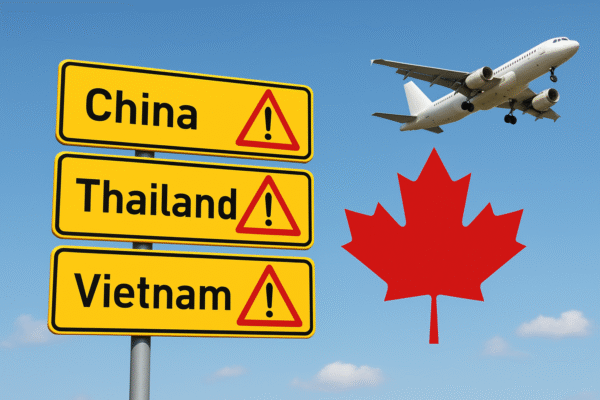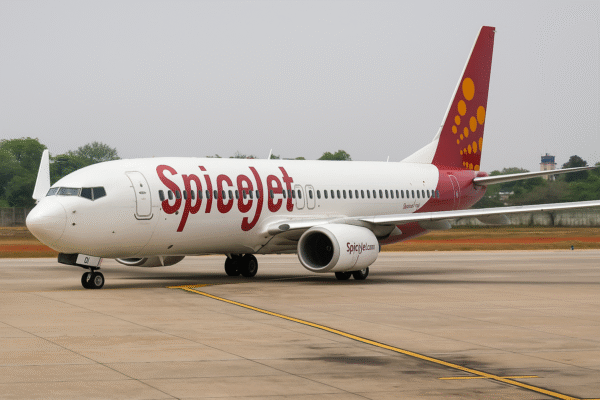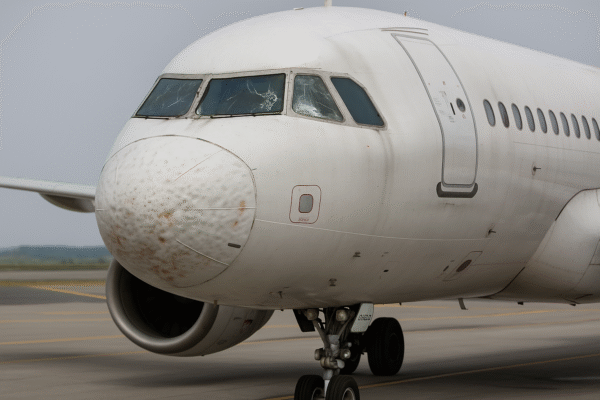Thai AirAsia Flight Severely Damaged by Hailstorm Over Chongqing, Passengers Safe and Return Flight Delayed
A Thai AirAsia flight from Bangkok to Chongqing faced extreme weather conditions as it descended into China on July 17, resulting in a violent hailstorm that significantly damaged the aircraft’s nose cone and cockpit windshield. The Airbus A320, operating flight FD552, managed to land safely at Chongqing Jiangbei International Airport with all 147 passengers and crew unharmed.
The aircraft, registered as HS-BBA, departed Don Mueang International Airport in Bangkok in the early hours of July 17. The journey was uneventful until the descent phase into Chongqing, when the aircraft encountered rapidly deteriorating weather conditions. According to passenger accounts and airline statements, the flight was subjected to intense turbulence and hail strikes, which caused visible external damage to the aircraft.
Photos of the aircraft post-landing revealed a severely dented nose cone and cracked cockpit windows, underlining the ferocity of the hailstorm. Despite the terrifying experience, Thai AirAsia praised the flight crew for their professionalism in ensuring a safe landing under such extreme conditions.
In a statement, Thai AirAsia confirmed:
“All safety procedures were followed in accordance with international aviation standards. The aircraft’s structural integrity was maintained throughout the landing. Passenger safety remains our top priority.”
Upon landing, the Airbus A320 was immediately taken out of service for technical inspection and damage assessment. The hailstorm impact, though not compromising the flight’s safety during descent, was deemed serious enough to ground the aircraft until repairs could be arranged.
Passengers Describe a Harrowing Descent
Passengers onboard FD552 described the descent as “terrifying,” with the aircraft shaking violently amid loud impacts from hailstones. Some travelers reported visible anxiety and fear, though cabin crew remained calm and provided continuous updates throughout the ordeal.
“Everyone was scared, but the staff stayed calm. We really appreciated that,” said one passenger from Bangkok. “You could hear the hail pounding the plane. It felt like being inside a washing machine.”
Despite the damage, there were no injuries reported. The smooth emergency handling by both the cockpit and cabin crew was widely praised by travelers and aviation observers alike.
Return Flight FD553 Delayed as Safety Measures Take Priority
The return flight to Bangkok, FD553, was significantly delayed as ground crews and engineers inspected the damage. Thai AirAsia swiftly organized accommodations, meals, and airport assistance for affected passengers while sourcing a replacement aircraft.
The replacement flight departed the following morning, July 18, after all safety checks were completed. Passengers were reportedly relieved and appreciative of Thai AirAsia’s clear communication and rapid response.
One Chongqing-based passenger noted,
“They handled it well. We were offered hotel stays, meal vouchers, and constant updates. Safety was clearly more important than speed.”
Aviation Safety and Weather Monitoring in Focus
The incident has reignited discussion about the unpredictable nature of weather-related aviation hazards, particularly in Asia’s summer monsoon and typhoon seasons. According to the Civil Aviation Authority of Thailand (CAAT) and the Civil Aviation Administration of China (CAAC), airlines are increasingly investing in weather forecasting technologies and pilot simulation training to prepare for such extreme meteorological phenomena.
Thai AirAsia is reportedly conducting an internal review in cooperation with Chinese aviation authorities to assess radar weather monitoring and real-time data systems during approach procedures. The airline stressed that this event was a rare occurrence, highlighting the overall safety and resilience of modern aircraft structures.
Experts say that while hailstorms remain difficult to predict with pinpoint accuracy, newer aircraft radar systems and pilot alert protocols have dramatically improved incident response. Airbus, the manufacturer of the A320, designs aircraft noses and cockpits to withstand intense weather conditions, though localized hail impact can still cause considerable repair needs.
No Further Incidents Reported, Flights Resume
As of July 20, Thai AirAsia has resumed normal operations on the Bangkok-Chongqing route. No further weather-related delays or cancellations have been reported. Travelers flying between Southeast Asia and southwestern China are advised to monitor weather updates during the summer season, particularly between June and September when convective storms are more common.
Thai AirAsia expressed its gratitude to passengers for their patience and reaffirmed its commitment to the highest safety standards across its operations. The airline also thanked Chinese aviation authorities and Chongqing airport staff for their swift coordination in managing the incident.
Conclusion
The July 17 hailstorm incident involving Thai AirAsia’s FD552 flight stands as a powerful reminder of the unpredictability of severe weather in aviation. While the flight’s safe landing and lack of injuries are reassuring, it also underscores the importance of robust response systems, real-time communication, and safety-first operational protocols.
For the passengers and crew of FD552, the experience was unnerving—but their safety, ultimately preserved by the airline’s professionalism, was never compromised. As climate volatility continues to affect global travel patterns, such events may become more frequent, prompting airlines to reinforce weather preparedness.
Thai AirAsia continues to serve passengers with full schedules, monitoring meteorological conditions closely and collaborating with regional aviation bodies to ensure traveler safety and peace of mind.
For more travel news like this, keep reading Global Travel Wire





















